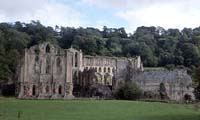| |
 |
Rievaulx (North Yorkshire) Rievaulx Abbey |
The name Rievaulx is a Norman French reworking of English 'Rye' and Latin vallis - the valley of the River Rye in which, in 1132, the first Cistercian abbey in the north of England was constructed. The site was granted by Walter L'Espec, lord of nearby Helmsley Castle.
Much of what can be seen today dates to the time of Abbot Aelred (1137 - 67), one of the most renowned scholars of his day, when there were 140 monks and 600 lay brothers in residence.
The abbey church was cruciform; the chancel is a rebuild of the 1220s, but the remainder dates to the 1150s. As can be seen in the transepts, it embodies the austerity of early Cistercian architecture, decoration being largely absent. At the west end a small Galilee chapel stood before the main door. In the manner of the mother house at Clairvaux and the Norman Minster at York, the church walls were probably given a whitewash coating onto which false stone joints were painted.
South of the church was the main cloister. The principal building on the east side was the chapter house. It had an eastern apse and an arcade supported a clerestory above the aisle roofs. Another splendid building, the refectory, aligned according to Cistercian custom, north - south, stood on the south side of the cloister. As the ground slopes down to the south, there is space for an undercroft for kitchens and storage. The main hall was entered through a richly moulded doorway flanked by wash basins. Other 12th century buildings of which remains survive include the monks' dormitory and infirmary cloister.
Bibliography
Coppack, G. and Fergusson, P., undated. Rievaulx Abbey (English Heritage)
Fergusson, P. and Harrison, S., 1999. Rievaulx Abbey: Community, Architecture, Memory (Yale)
Pevsner, N., 1966. The Buildings of England, Yorkshire: the North Riding (London, Penguin), 299-307